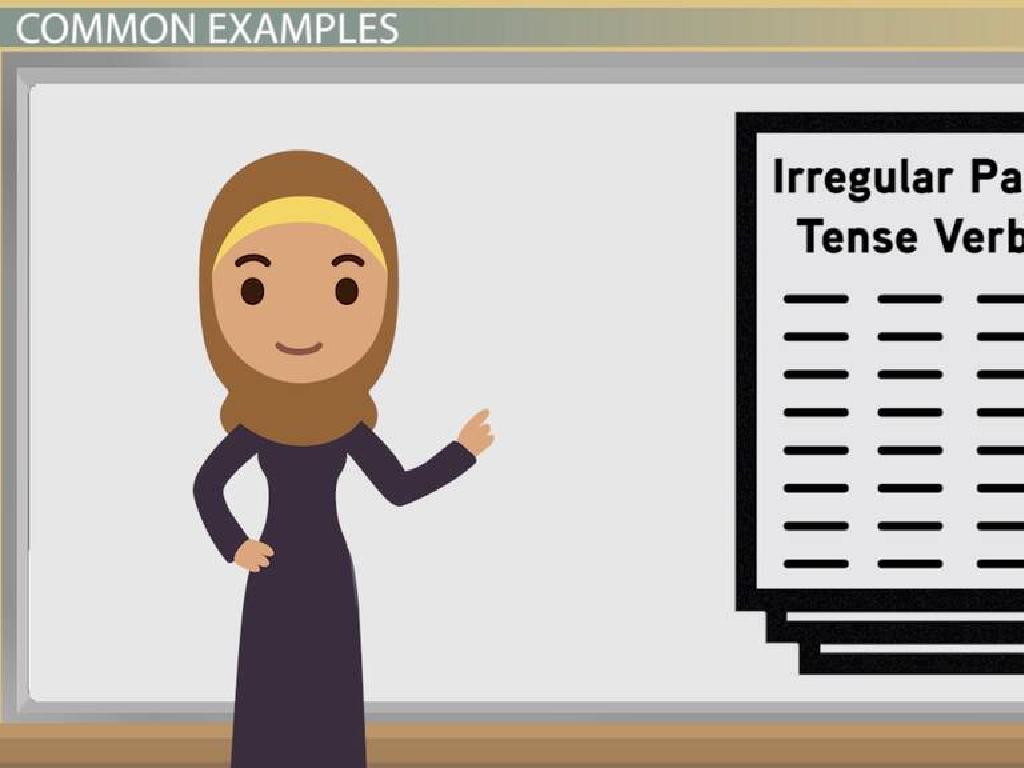Find The Number Of Solutions To A System Of Equations
Subject: Math
Grade: Eighth grade
Topic: Systems Of Equations
Please LOG IN to download the presentation. Access is available to registered users only.
View More Content
Exploring Systems of Equations
– Define systems of equations
– A set of two or more equations with the same variables
– Systems in real life
– Budgeting, mixing solutions, or planning trips
– Meaning of ‘solutions’
– Solutions are where equations intersect
– Types of solutions
– One, none, or infinitely many solutions
|
This slide introduces students to the concept of systems of equations, which are foundational in algebra. Begin by defining a system of equations as a set that consists of two or more equations with the same variables. Provide relatable real-life scenarios where systems of equations are applicable, such as budgeting money, mixing different solutions in chemistry, or planning trips. Clarify that ‘solutions to a system’ refer to the points where the equations intersect on a graph, representing the values that satisfy all equations simultaneously. Discuss the different types of solutions a system can have: one solution (intersecting lines), no solution (parallel lines), or infinitely many solutions (coincident lines). Encourage students to think of other real-life examples and to visualize the concept by graphing simple systems.
Classifying Systems of Equations
– Consistent Systems: Existence of solution
– A system that intersects at least at one point
– Inconsistent Systems: No solution
– Dependent Systems: Infinite solutions
– Lines coincide, sharing all points
– Determining the system type
– Use graphing, substitution, or elimination to classify
|
This slide aims to help students understand the different types of systems of equations. Consistent systems have at least one solution, meaning the lines intersect at a point, representing the solution to the system. Inconsistent systems have no solutions; the lines are parallel and never intersect. Dependent systems have infinitely many solutions because the lines coincide, meaning they are the same line and share all points. To determine the type of system, students can use methods such as graphing, substitution, or elimination. It’s crucial to provide examples of each system type and practice problems to solidify their understanding. Encourage students to visualize each system by sketching graphs and to verify their answers using algebraic methods.
Graphical Method: Solutions to Systems of Equations
– Plot both equations on a graph
– Use graph paper or a digital tool to draw accurate lines or curves for each equation.
– Look for the intersection point
– The point where the lines cross is the intersection.
– Determine the solution from the graph
– If lines intersect, the coordinates of that point are the solution (x, y).
– Understand what the solution means
– The solution represents the values that satisfy both equations simultaneously.
|
This slide introduces the graphical method for finding the number of solutions to a system of equations. Students will learn to plot each equation on the same graph and look for points of intersection, which represent the solutions to the system. Emphasize the importance of accurate plotting for correct interpretation. Discuss different scenarios: one solution (intersecting lines), no solution (parallel lines), and infinitely many solutions (coincident lines). Provide examples with different types of equations (linear, quadratic) to illustrate the concept. Encourage students to practice this method with various systems to become comfortable with the process.
Algebraic Methods to Solve Systems of Equations
– Substitution Method
– Replace one variable with its equivalent from the other equation.
– Elimination Method
– Add or subtract equations to eliminate a variable.
– Comparing Coefficients
– Check if the coefficients lead to one, none, or infinite solutions.
– Determining Number of Solutions
|
This slide introduces students to the algebraic methods for solving systems of equations. The substitution method involves solving one equation for one variable and then substituting that expression into the other equation. The elimination method requires adding or subtracting the equations to cancel out one of the variables. Comparing coefficients helps to determine the number of solutions; if the ratios of the coefficients of the variables are the same but the constant term is different, there are no solutions; if the ratios are different, there is one solution; if all ratios are the same, there are infinitely many solutions. Encourage students to practice each method with different systems to become comfortable with identifying the most efficient method for each system.
Solutions to a System of Equations
– One solution: Intersecting lines
– When two lines cross at one point
– No solution: Parallel lines
– Lines that never meet, no intersection
– Infinitely many: Coinciding lines
– Lines that lie on top of each other
|
This slide is aimed at helping students understand the possible outcomes when solving a system of linear equations. Each system can have one, none, or infinitely many solutions. One solution occurs when the graph of the equations results in intersecting lines, which means they meet at a single point. No solution is the result when the lines are parallel, as they will never intersect. Infinitely many solutions happen when the lines coincide, meaning they are the same line and thus intersect at every point along the line. Encourage students to graph different systems to visually see these outcomes and reinforce the concepts with examples.
Determining the Number of Solutions
– Analyze coefficients & constants
– Compare the ratios of coefficients and constants to predict the number of solutions.
– Solve systems algebraically
– Use substitution or elimination methods to find solutions.
– Explore solution types
– No solution, one solution, or infinitely many solutions.
– Practice with examples
– Apply methods to equations like y=2x+3 and y=2x-4.
|
This slide aims to teach students how to determine the number of solutions in a system of equations. Start by explaining the significance of coefficients and constants in equations and how their ratios can indicate the number of solutions. Demonstrate algebraic methods such as substitution and elimination to solve for variables. Discuss the different types of solutions: a single solution (intersecting lines), no solution (parallel lines), and infinitely many solutions (coincident lines). Provide examples of each type and encourage students to solve them. This will help students visualize and understand the concepts better. The examples chosen should be simple enough for eighth graders to follow but also challenging enough to stimulate their problem-solving skills.
Class Activity: Exploring Solutions to Systems
– Group activity: solve systems of equations
– Present your solving method
– Share the steps your group took to find the solution
– Discuss different solving approaches
– Compare how each group approached the problem
– Reflect on the learning experience
– Think about what was learned from this activity
|
This slide sets up a collaborative class activity where students will work in groups to solve different systems of equations. Each group will use their preferred method, such as graphing, substitution, or elimination, to find the solutions. After solving, groups will present their methods and solutions to the class, fostering a discussion on the various techniques used. The teacher should facilitate the discussion, guiding students to reflect on the efficiency and effectiveness of each method. This activity encourages peer learning and critical thinking as students evaluate different approaches to problem-solving. The teacher should prepare multiple systems of equations in advance, ensuring a range of difficulties to cater to all students. Possible extensions could include challenging students to create their own systems for others to solve.
Conclusion: Systems of Equations Solutions
– Recap: Systems of Equations
– A system of equations can have one, none, or infinite solutions.
– Understanding solution significance
– Knowing how many solutions helps solve real-world problems.
– Homework: Practice problem set
– Solve assigned problems to identify the number of solutions.
– Be prepared to discuss solutions
– We’ll review different solution scenarios in class.
|
This slide wraps up the lesson on systems of equations by summarizing the key points and emphasizing the importance of understanding the number of solutions. It’s crucial for students to recognize the different types of solutions: one solution (intersecting lines), no solution (parallel lines), or infinitely many solutions (same line). The homework assignment will reinforce this concept by providing practice problems that require students to determine the number of solutions for various systems. In the next class, we will discuss their answers and address any difficulties encountered. This practice will not only solidify their understanding but also prepare them for applying these concepts to complex problems.






